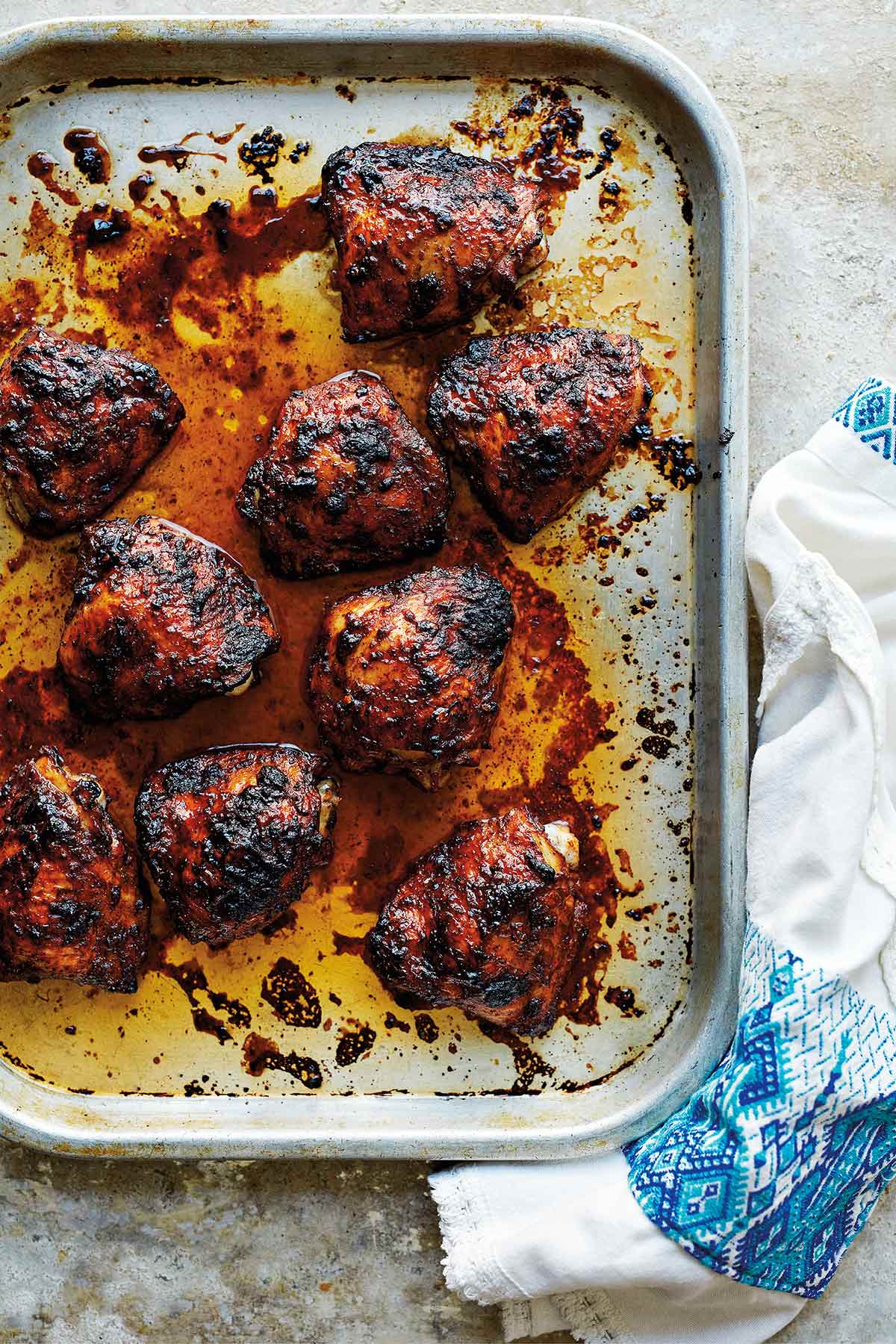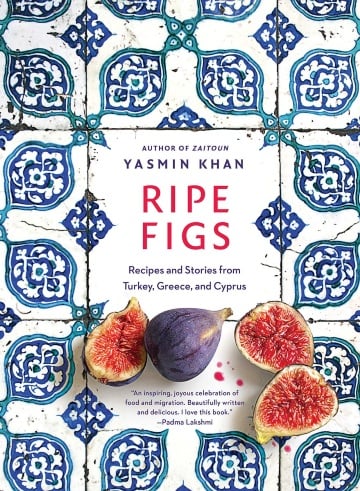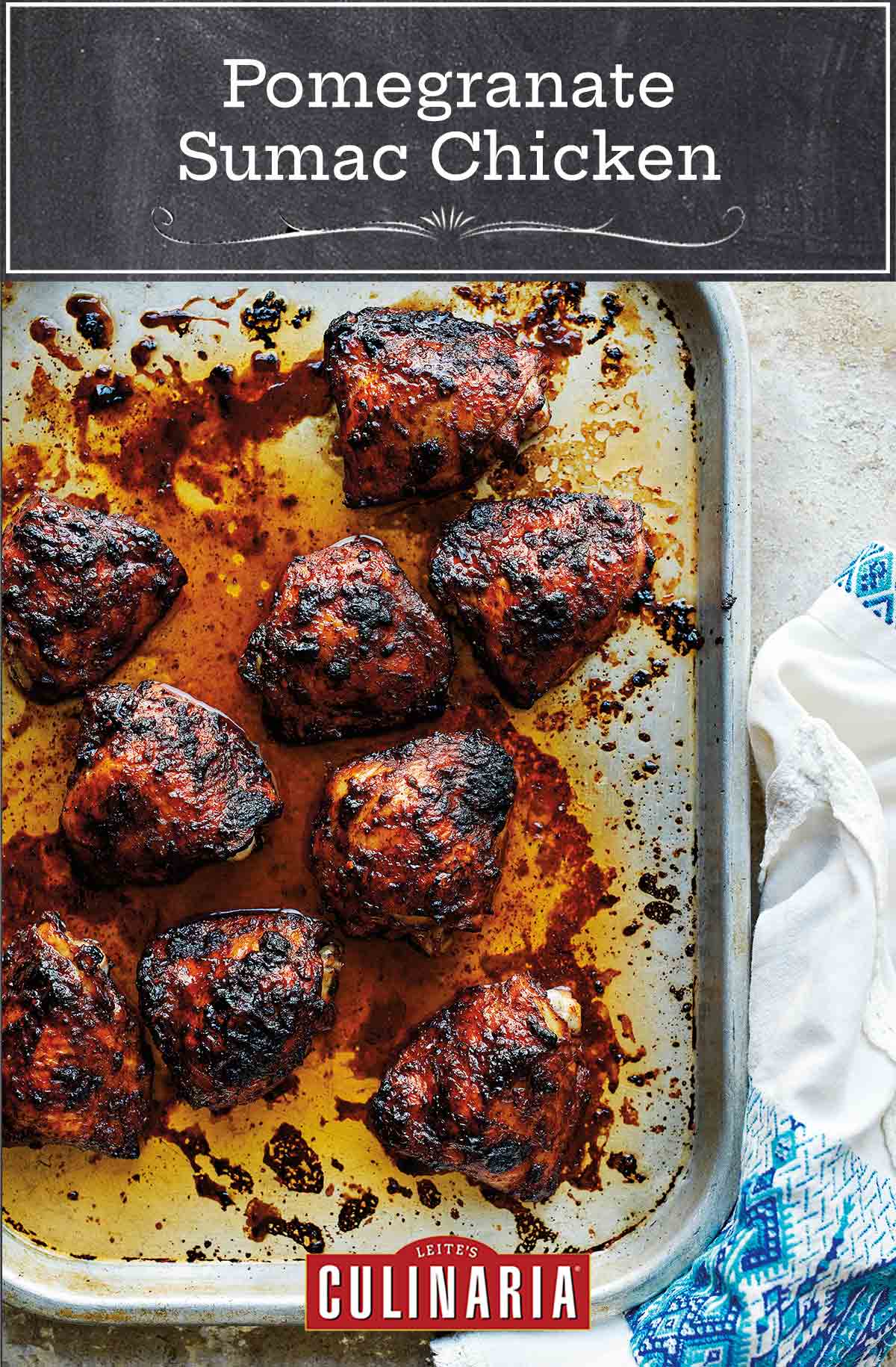
This is an easy chicken sheet pan recipe inspired by a meal I ate at Reem, a restaurant on the Greek island of Lesvos run by Mahmud Talli. Mahmud is a powerhouse of energy and, when I met him, he was splitting his time between volunteering at a local community center and running the restaurant.
Want to save this?
A Syrian doctor who managed to escape the war, Mahmud found himself trapped on the island after seeking refuge there, and soon put all his efforts into helping to provide services for new arrivals to Lesvos. Reem serves traditional Syrian food to hungry tourists, volunteers, locals, and refugees alike and this was one of my favorite dishes on the menu.–Yasmin Khan
Featured Review
These things were scrumptious, the pom molasses and sumac are such a flavor bomb! Next time I will try these on the Blackstone, it was just too bloody hot out yesterday. I made extra because this chicken will make an excellent pita Sammie! YUMMILICIOUS!
BBQGODDESS

Pomegranate Sumac Chicken
Ingredients
For the marinade
- 3 tablespoons pomegranate molasses
- 1 tablespoon store-bought or homemade tomato paste
- 1/2 teaspoon ground allspice
- 2 teaspoons pul biber (Aleppo pepper*)
- 1 teaspoon ground sumac
- 2 fat garlic cloves, crushed
- Kosher salt and freshly ground black pepper
For the chicken
- 8 large bone-in chicken thighs or a whole chicken (about 3 lbs | 1.4 kg), cut into 8 pieces
- 3 tablespoons olive oil
Instructions
Make the marinade
- In a large bowl, combine all the marinade ingredients with 1 1/2 teaspoons salt and 1/2 teaspoon black pepper.
Marinate the chicken
- Add the chicken to the marinade and, using your hands, massage the chicken until it is evenly coated, then cover and stash in the refrigerator to marinate for at least 3 hours and up to 24 hours.
- When you're ready to cook, take the chicken out of the refrigerator and let it come to room temperature (this will take about 20 minutes).
- Preheat the oven to 400°F (200°C).
☞ TESTER TIP: Line your sheet pan with foil for easier clean up.
- Place the chicken skin side up on a rimmed baking sheet and drizzle with the olive oil. Roast until the juices from the chicken run clear when it is pierced at the thickest part, and the internal temperature is 165°F (74°C), 30 to 35 minutes.
Notes
*What is Aleppo pepper?
Named after the Syrian city, Aleppo pepper is a brightly colored, mildly spicy dried pepper that has a unique taste—a little raisiny, a little tomatoey, a little peppery. It’s widely used in the Middle East and is becoming more popular in North America. It makes a terrific replacement for the ubiquitous red chile flake, but with a little more flavor. At the same time, you can use red chile flakes, hot paprika, or ancho chiles if you can’t find Aleppo pepper.
Explore More with AI
Nutrition
Nutrition information is automatically calculated, so should only be used as an approximation.
Recipe Testers’ Reviews
Two of my favorite pantry staples are pomegranate molasses and sumac, but I sometimes struggle with using them since there aren’t many recipes in my repertoire that incorporate them. This recipe for pomegranate sumac chicken, fortunately, finds a way to pair them together in a way that made me say, “Why didn’t I think of that?”
My favorite trait of pomegranate molasses is that it caramelizes beautifully. This definitely had a positive effect on how the thigh skin cooked—subtly crispy, full of flavor, nicely rendered. *chef’s kiss* Underneath the flavorful blanket on top was tender, succulent meat, perfectly cooked and waiting to be savored.
Thanks to its marinating time, the skin’s punchy flavors also had a bit of presence in the thigh meat. The fruity sumac and warm allspice flavors, for example, played nicely in the background with the meat’s overwhelming juiciness. I wasn’t getting much flavor from the garlic, though, so I’d probably grate the cloves into the marinade instead of crushing them the next time I make this. I served the chicken with roasted carrots and fennel.
As much as I love its effect on food, the molasses’ strength is a huge weakness when it comes to cleaning. Because it caramelizes so quickly, it often evolves into burnt concrete on your pan by the time your food’s done roasting in the oven. In this situation, you could probably avoid a lot of soaking and strenuous scrubbing afterward by propping the thighs on top of a rack over your sheet pan prior to sticking it in the oven.
This pomegranate sumac chicken is an easy, flavorful weeknight chicken dish that the family enjoyed, and it helped round out a little (maybe big) discussion on the Middle East, too. It was nice to use a good amount of spices in my drawer that aren’t called for often: sumac, Aleppo chile, and allspice, plus that bottle of pomegranate molasses which rounded out the spice with a little tangy sweet–it’s SO good.
We wanted an appropriate side, so Googled sumac chicken and found a recipe for cucumbers with yogurt and red onion but it was a little heavy on the yogurt. Something between that and an Asian cucumber salad would be nice. Maybe hummus would be a better starter? We tried a Spanish Basque region white that wasn’t quite right, nor was the red we went to—an opportunity for exploration all around.
I love Middle Eastern food and this Syrian recipe for pomegranate sumac chicken is not only delicious but very quick and easy. The pomegranate molasses and sumac play off of each other to give the dish a nice sweet/sour tang; we mopped the pan drippings with chunks of pita bread. I served this with a watermelon, halloumi, and za’atar salad, Israeli couscous and parsley salad, pita bread, and a crisp rosé.
This pomegranate sumac chicken is such an easy route to gorgeously satisfying chicken—this may be my new favorite easy chicken dinner. It takes no time at all to prepare the marinade, and is easily scaled up or down. The intrigue of the recipe origin may have drawn me in—my family is from Lesvos and I am very familiar with the influx of Syrian refugees. I’m happy to see the cuisine represented in such a lovely way.
I scaled this to a half recipe, and using medium-sized thighs, it served two very happy people. Once prepared, after completely massaging the marinade into the thighs, I found it was easy to leave them skin side down in the container in a single layer so that any marinade that dripped down would be giving a bit extra to the skin side. When I placed the pieces skin side up on the roasting tray, I also made sure I had scraped every bit of the dark, almost molasses-colored marinade onto the chicken.
The timing was spot on, and while the chicken rested for 5-7 minutes, I tented it with foil to keep it warm and popped the oven up to 450°F to finish browning the potatoes I had cooked alongside in a separate pan, completely a perfect Mediterranean & Aegean meal. I thought it was perfect, but you could also increase the sumac and Aleppo pepper and be very happy with the result.
I served the chicken with oven-roasted potatoes (lemon, oregano, EVOO, and chicken broth, which I started half an hour before the chicken as they could cook at the same temperature, then when the chicken was removed, bumped up the temp for extra browning.) We also had a salad of kohlrabi, oranges, and carrots for starters with a preserved lemon dressing.
This recipe for pomegranate sumac chicken is a nice introduction to two ingredients some cooks may not be familiar with—pomegranate molasses and sumac. Though I’d recommend a long marinade (I did 10 hours), the actual work involved is very, very minimal. I found it very easy to prepare the marinade in the morning and then come home later that evening to finish with cooking. All the flavors will be mild and would appeal to a range of palates.
If you’re looking for a punchier chicken, I’d advise increasing your spices a touch. This was a great main dish on a super-hot summer night, as the cooking time was pretty short. I served this with a green salad and a vinegar-based potato salad with capers, herbs, and garlic scapes.
The marinade for this pomegranate sumac chicken dish was quick and easy to throw together, using ingredients that I always have in the house. The result yielded nice flavors and very tender chicken. I let my chicken marinate for 5 hours because I got started later than I thought I would. I want to try making this recipe with boneless, skinless chicken thighs, and let it marinate longer next time.
Although I really enjoy crispy skin, in this case the skin did not get crisp. I know that I could have put the sheet pan under the broiler, but at that moment, my conscience got the better of me, and I decided that I should get us to be heart-healthy, and I didn’t do that. I cooked the chicken until it reached an internal temperature of 165°F. I served this dish with potatoes with tomatoes and feta. They worked very nicely together. Perhaps the Aleppo pepper in each dish, had something to do with that.
This pomegranate sumac chicken is a very flavorful dish. I have just recently discovered pomegranate molasses and love the concentrated pomegranate flavor. My eight chicken thighs weighed in at 3 lbs. I let them marinate all day, approximately 8-1/2 hours so they were ready to roast in the afternoon. Since the thighs were relatively small, they were ready at the 25-minute mark but didn’t have the color I wanted so I turned on the broiler for just a few minutes to caramelize them. Since the recipe is so close to Fesenjoon, I served the chicken with saffron rice and a cucumber and tomato salad. I have discovered that I actually prefer this recipe to fesenjoon because I love the lemony flavor of sumac and the tartness of the pomegranate.

















This recipe is a keeper! Absolutely divine. I was nervous about the sumac because I have never had it before. And I have only had pomegranate molasses in home made grenadine. This recipe is going into our regular rotation. LOVED IT!
Nancy, I love that you stepped out of your comfort zone with the sumac and pomegranate molasses, and then got wound up with something “absolutely divine!” I’m delighted it’s going into your regular rotation; that’s the ultimate compliment. I hope it continues to impress—let me know how it goes next time you make it!
These things were scrumptious, the pom molasses and sumac are such a flavor bomb! Next time I will try these on the Blackstone, it was just too bloody hot out yesterday. I made extra because this chicken will make an excellent pita Sammie! YUMMILICIOUS!
BBQG, you need an apron embroidered with “Yummilicious” stat. I love that you found the pomegranate molasses (one of my fave ingredients) and sumac combo as explosive as I do. And yes—a Blackstone trial sounds like a fab idea, especially when the sun’s trying to melt us all. Extra chicken for pita sammies? You are a woman after my own heart. Let me know how the flat-top version goes—I’m all ears!
Flavorful dish. I used pomegranate balsamic in lieu of molasses and marinated for 24 hours. The foil lined pan was a great suggestion.
Thanks, MM!